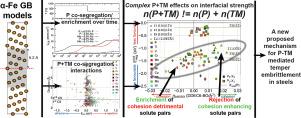Acta Materialia ( IF 8.3 ) Pub Date : 2023-03-20 , DOI: 10.1016/j.actamat.2023.118850 Han Lin Mai , Xiang-Yuan Cui , Daniel Scheiber , Lorenz Romaner , Simon P. Ringer

|
The phenomenological interplay in the segregation of phosphorus (P) and transition metal (TM) elements at grain boundaries (GBs) in steels has long been suspected to be the main contributor to temper embrittlement. However, many of the details remain unclear. Here, we investigate the segregation, co-segregation and cohesion effects of TMs (Co, Cr, Cu, Mn, Mo, Ni, Nb, Ti, V, W) along with P in various ferritic iron (-Fe) GBs utilising density functional theory and simulations of kinetics. Our findings demonstrate that P is unlikely to cause intergranular fracture via weakened interfacial bonding when segregated by itself. Nevertheless, the stronger segregation binding of P compared to TMs can explain the ubiquitous presence of P segregated at GBs. We find that most P-TM interactions at ferritic GBs are repulsive and differ significantly from the corresponding interactions in the bulk. Due to the repulsive interactions and strong segregation binding of P, the enrichment of P over time at GBs leads to the depletion of prior-segregated cohesion-enhancing solutes at general GBs. Additionally, certain P-TM co-segregation combinations that are cohesion-lowering are energetically favoured at such GBs. We posit these mechanisms act in tandem as critical causalities of P-induced temper embrittlement in alloyed steels. Finally, we reveal a contradiction in the predicted cohesion effects of segregated P calculated in the Rice–Thomson–Wang theory of interfacial embrittlement compared to that as assessed by chemical bonding strength, calculated in the DDEC6 bond-order framework. These findings have important implications for GB engineering for interfacial cohesion.
中文翻译:

铁素体铁晶界中磷和过渡金属的共偏析及其对凝聚力的影响
长期以来,人们一直怀疑钢中晶界 (GB) 处磷 (P) 和过渡金属 (TM) 元素偏析的现象学相互作用是回火脆化的主要原因。然而,许多细节仍不清楚。在这里,我们研究了 TM(Co、Cr、Cu、Mn、Mo、Ni、Nb、Ti、V、W)与 P 在各种铁素体铁中的偏析、共偏析和凝聚效应(-Fe) GBs 利用密度泛函理论和动力学模拟。我们的研究结果表明,当 P 自身偏析时,P 不太可能通过减弱的界面结合导致晶间断裂。然而,与 TM 相比,P 的分离结合更强,这可以解释在 GB 处普遍存在的 P 分离。我们发现铁素体 GB 中的大多数 P-TM 相互作用是排斥性的,并且与本体中的相应相互作用有显着差异。由于 P 的排斥相互作用和强分离结合,随着时间的推移,P 在 GB 中的富集导致一般 GB 中先前分离的增强内聚性溶质的耗尽。此外,某些降低内聚力的 P-TM 共分离组合在此类 GB 中受到大力支持。我们认为这些机制协同作用是合金钢中 P 诱导的回火脆化的关键因果关系。最后,我们揭示了在界面脆化的 Rice-Thomson-Wang 理论中计算的偏析 P 的预测内聚效应与在 DDEC6 键序框架中计算的化学键合强度评估的预测相矛盾。这些发现对界面内聚力的 GB 工程具有重要意义。











































 京公网安备 11010802027423号
京公网安备 11010802027423号